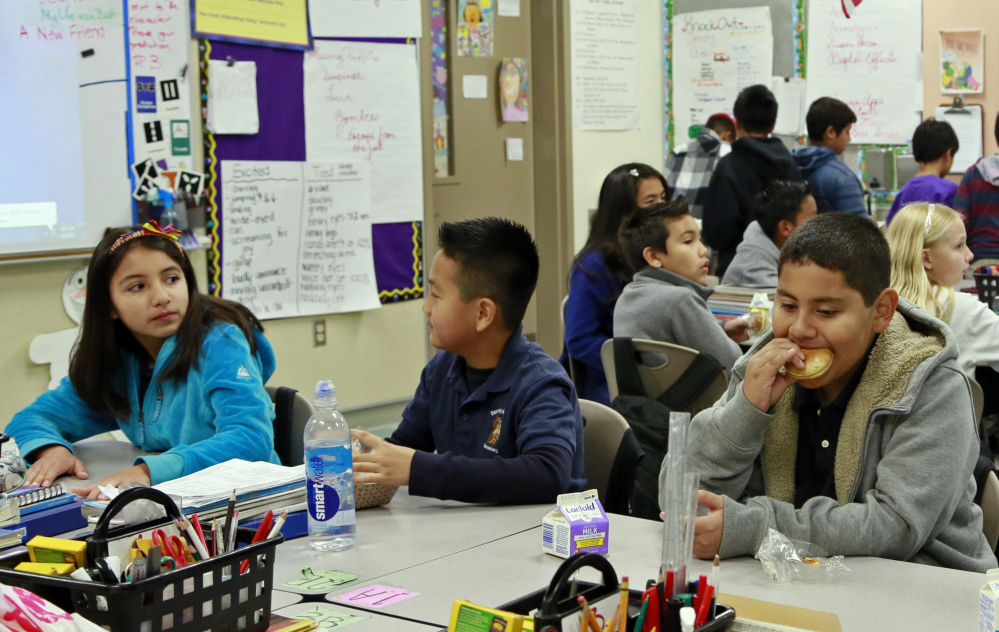LOS ANGELES — The number of breakfasts served in the nation’s schools has doubled in the last two decades, a surge driven largely by a change in how districts deliver the food.
Instead of providing low-income students free or reduced-price meals in the cafeteria, they’re increasingly serving all children in the classroom. Food policy advocates say the change increases equity, however, it’s fueled a backlash from parents and teachers. They contend that it takes up class time that should be devoted to learning and wastes food by serving it to kids who don’t want or need it.
Lilian Ramos, a mother of two elementary school children in a working-class Los Angeles neighborhood, said she takes offense at the district’s assumption that she hasn’t fed her children: She serves them a traditional Mexican breakfast each day.
“They say if kids don’t eat they won’t learn,” Ramos said. “The truth is that many of our kids come to school already having eaten. They come here to study.”
The Los Angeles Unified School District, the nation’s second-largest with about 650,000 K-12 students, has been aggressively expanding its program, and by the end of the school year, will be serving breakfast in class at nearly every school. That growth mirrors an increase nationwide. Since 1994, the number of breakfasts served has climbed from about 1 billion annually to 2.3 billion, according to the U.S. Department of Agriculture.
Across the country, 51 percent of children are considered low-income, up from 32 percent in 1989, according to the Southern Education Foundation. In a number of school districts, the vast majority of those children qualify for a free or reduced-price meal. In Los Angeles and Detroit, about 80 percent are eligible.
Proponents believe shifting breakfast from the cafeteria to the classroom is the most effective way to make sure all children are ready to learn. Students who come to school hungry, they argue, are likely to have a harder time paying attention.
There’s also a financial incentive for districts to expand breakfast. The federal government reimburses schools for each meal served. At LA Unified, the number of participating children has grown from 29 percent to 81 percent in three years, generating an additional $16 million, according to Laura Benavidez, the district’s deputy director of food services.
At Stanley Mosk Elementary, regarded as having a model breakfast program, teachers help distribute the meal, check off which students are eating and show a video to incorporate a nutrition lesson, all in 10 minutes. On a recent morning, students were given apples, cereal and a small, packaged breakfast sandwich. At the end of breakfast, there was a large cooler filled with uneaten breakfast sandwiches.
In Los Angeles, parents from wealthier schools organized against it, winning a concession permitting 32 schools with less than 20 percent of children who fall below the poverty threshold to opt out.
Parents at UCLA Community School, where Ramos’ children attend, also organized. They said the initiative took away instructional time from low-income and English-learner students, a group that scores persistently lower in reading and math. They also worried about unsanitary classrooms. The district temporarily delayed implementation but plans to soon start breakfast in the classroom at the school.
Copy the Story LinkSend questions/comments to the editors.



Success. Please wait for the page to reload. If the page does not reload within 5 seconds, please refresh the page.
Enter your email and password to access comments.
Hi, to comment on stories you must . This profile is in addition to your subscription and website login.
Already have a commenting profile? .
Invalid username/password.
Please check your email to confirm and complete your registration.
Only subscribers are eligible to post comments. Please subscribe or login first for digital access. Here’s why.
Use the form below to reset your password. When you've submitted your account email, we will send an email with a reset code.